Financial Accounting and Reporting: Fair Value Challenges Analysis
VerifiedAdded on 2022/11/18
|9
|2127
|124
Report
AI Summary
This report delves into the intricacies of fair value accounting within the conceptual framework, examining its definition, application, and the ongoing debates surrounding its use. It explores the shift in accounting paradigms towards market-based measures and analyzes the usefulness of fair value decisions as a management attribute. The report highlights the challenges associated with fair value measurement, including the relevance and reliability of market data, and the historical cost accounting. It also evaluates the shift from historical cost to fair value, considering the impact on financial reporting and decision-making, ultimately concluding that while fair value offers numerous benefits, the debate continues regarding its implementation and impact on financial statement users. The report uses information from the International Accounting Standards Board (IASB) and various research articles to support its arguments.
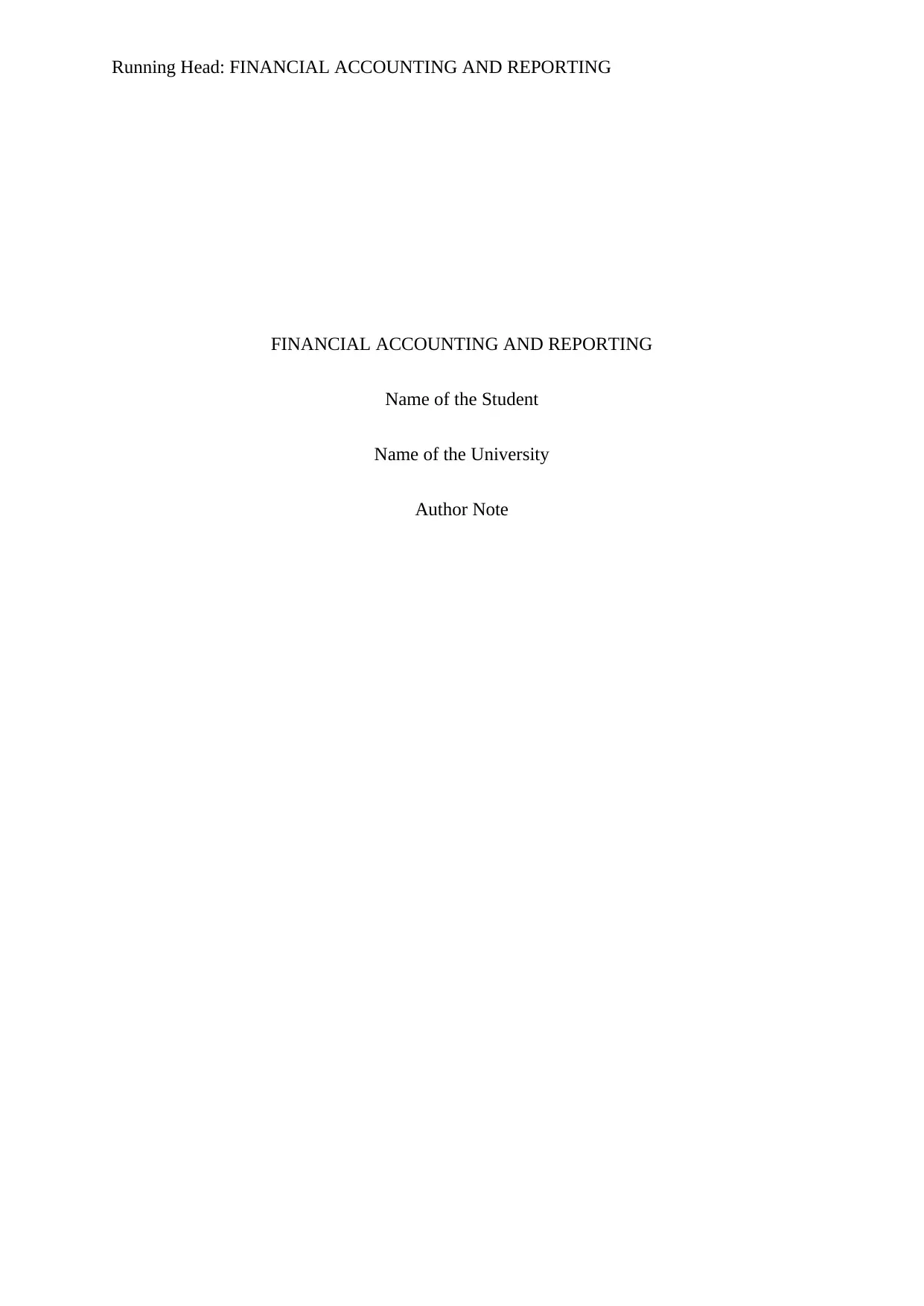
Running Head: FINANCIAL ACCOUNTING AND REPORTING
FINANCIAL ACCOUNTING AND REPORTING
Name of the Student
Name of the University
Author Note
FINANCIAL ACCOUNTING AND REPORTING
Name of the Student
Name of the University
Author Note
Paraphrase This Document
Need a fresh take? Get an instant paraphrase of this document with our AI Paraphraser
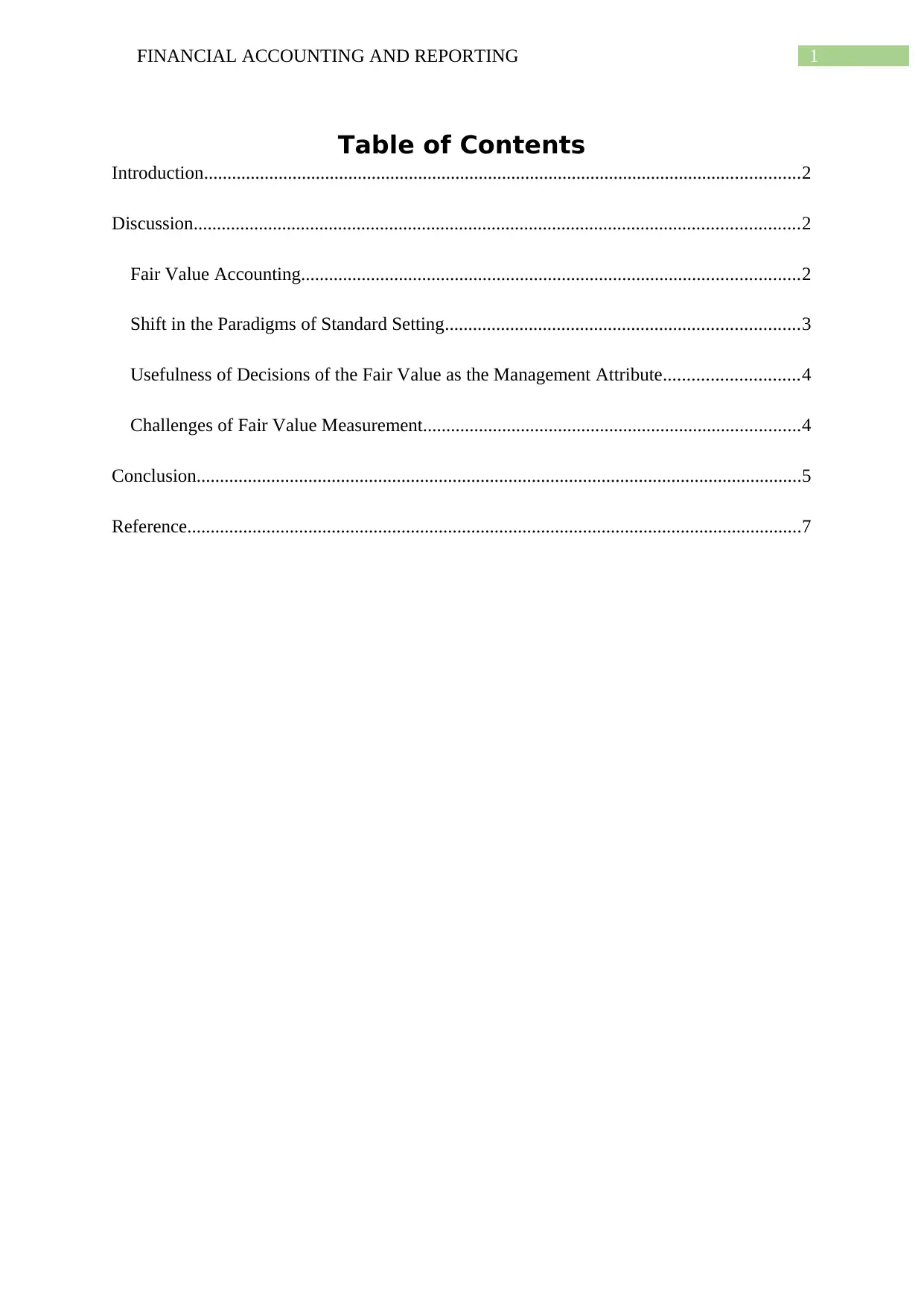
1FINANCIAL ACCOUNTING AND REPORTING
Table of Contents
Introduction................................................................................................................................2
Discussion..................................................................................................................................2
Fair Value Accounting...........................................................................................................2
Shift in the Paradigms of Standard Setting............................................................................3
Usefulness of Decisions of the Fair Value as the Management Attribute.............................4
Challenges of Fair Value Measurement.................................................................................4
Conclusion..................................................................................................................................5
Reference....................................................................................................................................7
Table of Contents
Introduction................................................................................................................................2
Discussion..................................................................................................................................2
Fair Value Accounting...........................................................................................................2
Shift in the Paradigms of Standard Setting............................................................................3
Usefulness of Decisions of the Fair Value as the Management Attribute.............................4
Challenges of Fair Value Measurement.................................................................................4
Conclusion..................................................................................................................................5
Reference....................................................................................................................................7
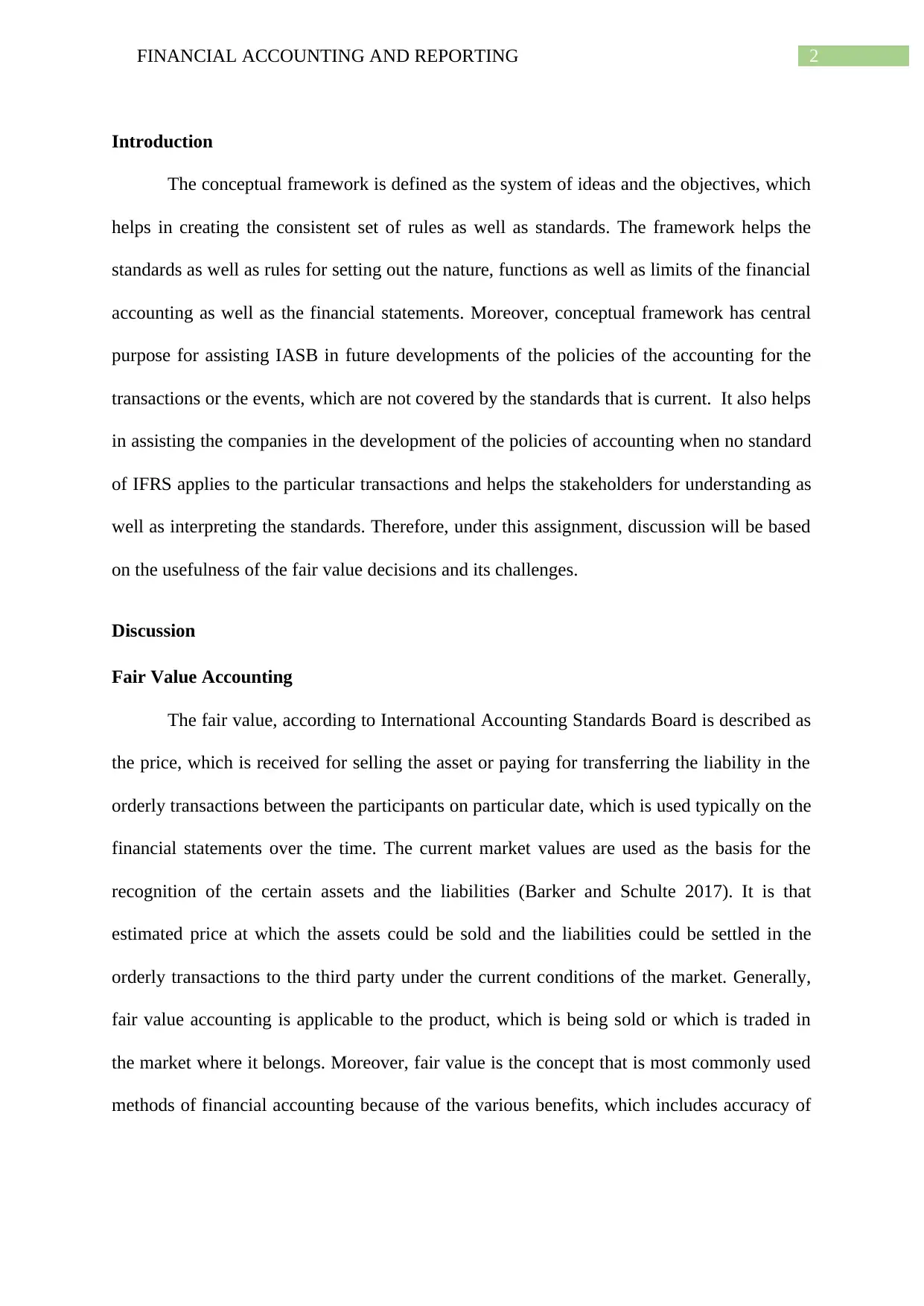
2FINANCIAL ACCOUNTING AND REPORTING
Introduction
The conceptual framework is defined as the system of ideas and the objectives, which
helps in creating the consistent set of rules as well as standards. The framework helps the
standards as well as rules for setting out the nature, functions as well as limits of the financial
accounting as well as the financial statements. Moreover, conceptual framework has central
purpose for assisting IASB in future developments of the policies of the accounting for the
transactions or the events, which are not covered by the standards that is current. It also helps
in assisting the companies in the development of the policies of accounting when no standard
of IFRS applies to the particular transactions and helps the stakeholders for understanding as
well as interpreting the standards. Therefore, under this assignment, discussion will be based
on the usefulness of the fair value decisions and its challenges.
Discussion
Fair Value Accounting
The fair value, according to International Accounting Standards Board is described as
the price, which is received for selling the asset or paying for transferring the liability in the
orderly transactions between the participants on particular date, which is used typically on the
financial statements over the time. The current market values are used as the basis for the
recognition of the certain assets and the liabilities (Barker and Schulte 2017). It is that
estimated price at which the assets could be sold and the liabilities could be settled in the
orderly transactions to the third party under the current conditions of the market. Generally,
fair value accounting is applicable to the product, which is being sold or which is traded in
the market where it belongs. Moreover, fair value is the concept that is most commonly used
methods of financial accounting because of the various benefits, which includes accuracy of
Introduction
The conceptual framework is defined as the system of ideas and the objectives, which
helps in creating the consistent set of rules as well as standards. The framework helps the
standards as well as rules for setting out the nature, functions as well as limits of the financial
accounting as well as the financial statements. Moreover, conceptual framework has central
purpose for assisting IASB in future developments of the policies of the accounting for the
transactions or the events, which are not covered by the standards that is current. It also helps
in assisting the companies in the development of the policies of accounting when no standard
of IFRS applies to the particular transactions and helps the stakeholders for understanding as
well as interpreting the standards. Therefore, under this assignment, discussion will be based
on the usefulness of the fair value decisions and its challenges.
Discussion
Fair Value Accounting
The fair value, according to International Accounting Standards Board is described as
the price, which is received for selling the asset or paying for transferring the liability in the
orderly transactions between the participants on particular date, which is used typically on the
financial statements over the time. The current market values are used as the basis for the
recognition of the certain assets and the liabilities (Barker and Schulte 2017). It is that
estimated price at which the assets could be sold and the liabilities could be settled in the
orderly transactions to the third party under the current conditions of the market. Generally,
fair value accounting is applicable to the product, which is being sold or which is traded in
the market where it belongs. Moreover, fair value is the concept that is most commonly used
methods of financial accounting because of the various benefits, which includes accuracy of
⊘ This is a preview!⊘
Do you want full access?
Subscribe today to unlock all pages.

Trusted by 1+ million students worldwide
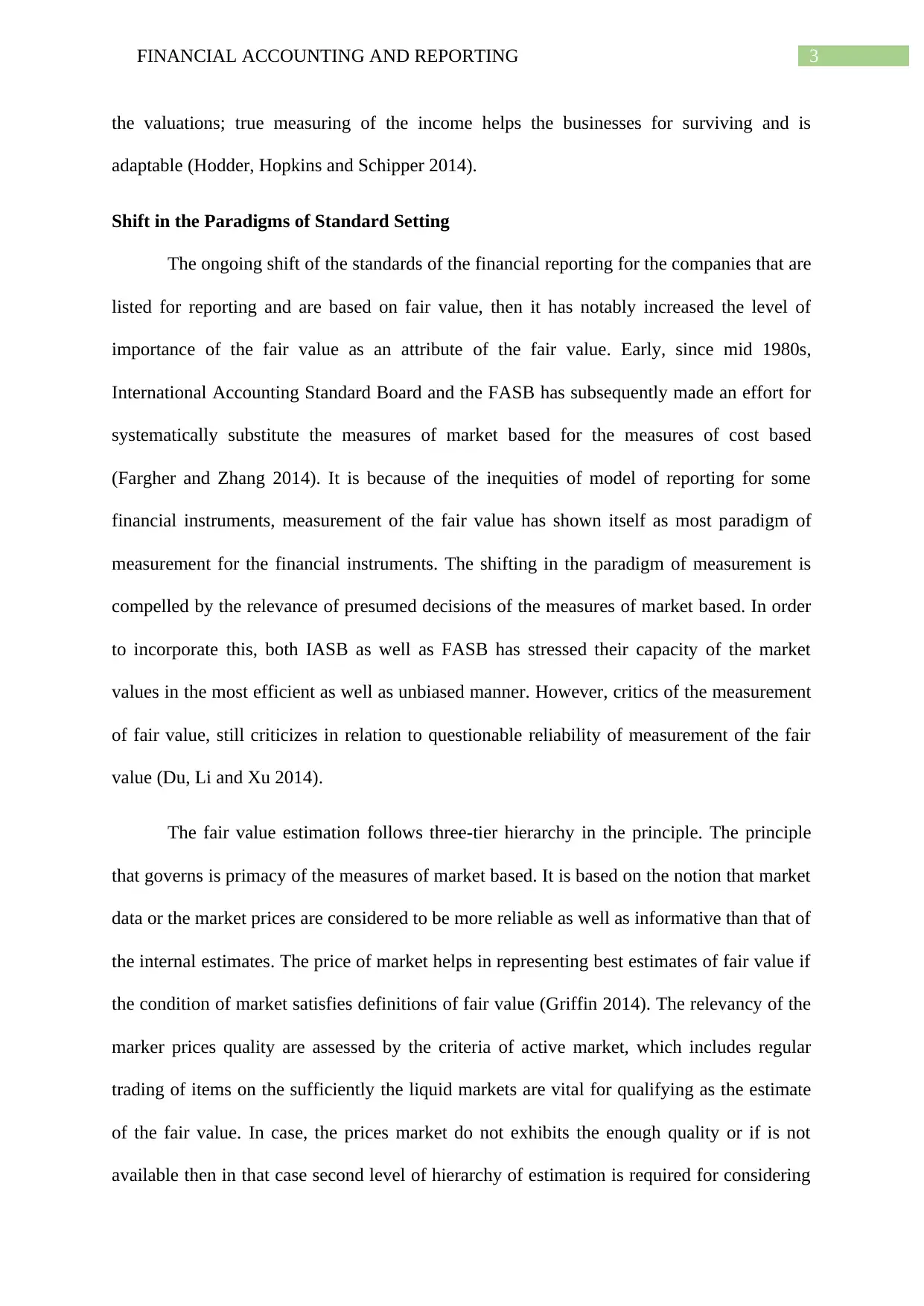
3FINANCIAL ACCOUNTING AND REPORTING
the valuations; true measuring of the income helps the businesses for surviving and is
adaptable (Hodder, Hopkins and Schipper 2014).
Shift in the Paradigms of Standard Setting
The ongoing shift of the standards of the financial reporting for the companies that are
listed for reporting and are based on fair value, then it has notably increased the level of
importance of the fair value as an attribute of the fair value. Early, since mid 1980s,
International Accounting Standard Board and the FASB has subsequently made an effort for
systematically substitute the measures of market based for the measures of cost based
(Fargher and Zhang 2014). It is because of the inequities of model of reporting for some
financial instruments, measurement of the fair value has shown itself as most paradigm of
measurement for the financial instruments. The shifting in the paradigm of measurement is
compelled by the relevance of presumed decisions of the measures of market based. In order
to incorporate this, both IASB as well as FASB has stressed their capacity of the market
values in the most efficient as well as unbiased manner. However, critics of the measurement
of fair value, still criticizes in relation to questionable reliability of measurement of the fair
value (Du, Li and Xu 2014).
The fair value estimation follows three-tier hierarchy in the principle. The principle
that governs is primacy of the measures of market based. It is based on the notion that market
data or the market prices are considered to be more reliable as well as informative than that of
the internal estimates. The price of market helps in representing best estimates of fair value if
the condition of market satisfies definitions of fair value (Griffin 2014). The relevancy of the
marker prices quality are assessed by the criteria of active market, which includes regular
trading of items on the sufficiently the liquid markets are vital for qualifying as the estimate
of the fair value. In case, the prices market do not exhibits the enough quality or if is not
available then in that case second level of hierarchy of estimation is required for considering
the valuations; true measuring of the income helps the businesses for surviving and is
adaptable (Hodder, Hopkins and Schipper 2014).
Shift in the Paradigms of Standard Setting
The ongoing shift of the standards of the financial reporting for the companies that are
listed for reporting and are based on fair value, then it has notably increased the level of
importance of the fair value as an attribute of the fair value. Early, since mid 1980s,
International Accounting Standard Board and the FASB has subsequently made an effort for
systematically substitute the measures of market based for the measures of cost based
(Fargher and Zhang 2014). It is because of the inequities of model of reporting for some
financial instruments, measurement of the fair value has shown itself as most paradigm of
measurement for the financial instruments. The shifting in the paradigm of measurement is
compelled by the relevance of presumed decisions of the measures of market based. In order
to incorporate this, both IASB as well as FASB has stressed their capacity of the market
values in the most efficient as well as unbiased manner. However, critics of the measurement
of fair value, still criticizes in relation to questionable reliability of measurement of the fair
value (Du, Li and Xu 2014).
The fair value estimation follows three-tier hierarchy in the principle. The principle
that governs is primacy of the measures of market based. It is based on the notion that market
data or the market prices are considered to be more reliable as well as informative than that of
the internal estimates. The price of market helps in representing best estimates of fair value if
the condition of market satisfies definitions of fair value (Griffin 2014). The relevancy of the
marker prices quality are assessed by the criteria of active market, which includes regular
trading of items on the sufficiently the liquid markets are vital for qualifying as the estimate
of the fair value. In case, the prices market do not exhibits the enough quality or if is not
available then in that case second level of hierarchy of estimation is required for considering
Paraphrase This Document
Need a fresh take? Get an instant paraphrase of this document with our AI Paraphraser
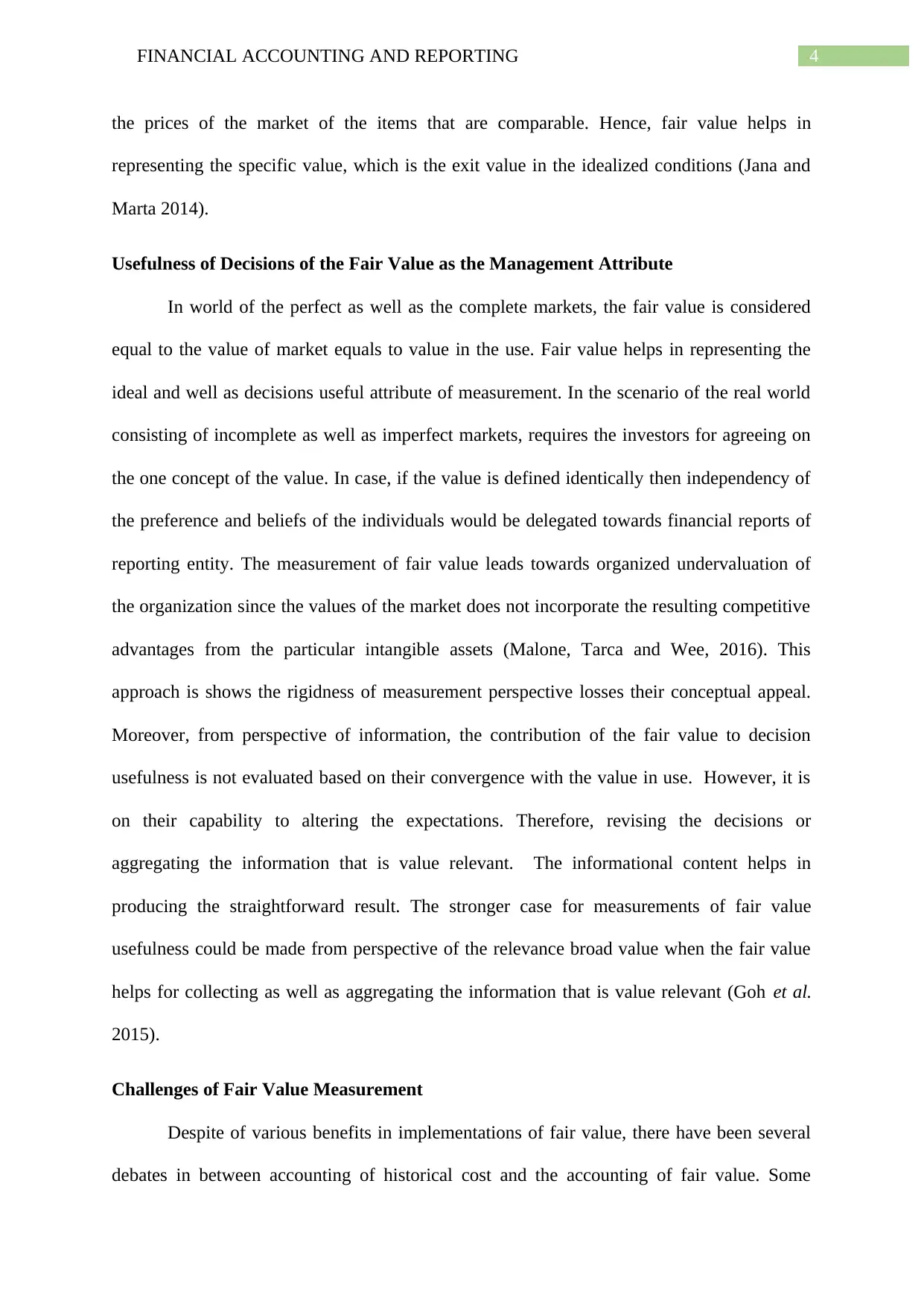
4FINANCIAL ACCOUNTING AND REPORTING
the prices of the market of the items that are comparable. Hence, fair value helps in
representing the specific value, which is the exit value in the idealized conditions (Jana and
Marta 2014).
Usefulness of Decisions of the Fair Value as the Management Attribute
In world of the perfect as well as the complete markets, the fair value is considered
equal to the value of market equals to value in the use. Fair value helps in representing the
ideal and well as decisions useful attribute of measurement. In the scenario of the real world
consisting of incomplete as well as imperfect markets, requires the investors for agreeing on
the one concept of the value. In case, if the value is defined identically then independency of
the preference and beliefs of the individuals would be delegated towards financial reports of
reporting entity. The measurement of fair value leads towards organized undervaluation of
the organization since the values of the market does not incorporate the resulting competitive
advantages from the particular intangible assets (Malone, Tarca and Wee, 2016). This
approach is shows the rigidness of measurement perspective losses their conceptual appeal.
Moreover, from perspective of information, the contribution of the fair value to decision
usefulness is not evaluated based on their convergence with the value in use. However, it is
on their capability to altering the expectations. Therefore, revising the decisions or
aggregating the information that is value relevant. The informational content helps in
producing the straightforward result. The stronger case for measurements of fair value
usefulness could be made from perspective of the relevance broad value when the fair value
helps for collecting as well as aggregating the information that is value relevant (Goh et al.
2015).
Challenges of Fair Value Measurement
Despite of various benefits in implementations of fair value, there have been several
debates in between accounting of historical cost and the accounting of fair value. Some
the prices of the market of the items that are comparable. Hence, fair value helps in
representing the specific value, which is the exit value in the idealized conditions (Jana and
Marta 2014).
Usefulness of Decisions of the Fair Value as the Management Attribute
In world of the perfect as well as the complete markets, the fair value is considered
equal to the value of market equals to value in the use. Fair value helps in representing the
ideal and well as decisions useful attribute of measurement. In the scenario of the real world
consisting of incomplete as well as imperfect markets, requires the investors for agreeing on
the one concept of the value. In case, if the value is defined identically then independency of
the preference and beliefs of the individuals would be delegated towards financial reports of
reporting entity. The measurement of fair value leads towards organized undervaluation of
the organization since the values of the market does not incorporate the resulting competitive
advantages from the particular intangible assets (Malone, Tarca and Wee, 2016). This
approach is shows the rigidness of measurement perspective losses their conceptual appeal.
Moreover, from perspective of information, the contribution of the fair value to decision
usefulness is not evaluated based on their convergence with the value in use. However, it is
on their capability to altering the expectations. Therefore, revising the decisions or
aggregating the information that is value relevant. The informational content helps in
producing the straightforward result. The stronger case for measurements of fair value
usefulness could be made from perspective of the relevance broad value when the fair value
helps for collecting as well as aggregating the information that is value relevant (Goh et al.
2015).
Challenges of Fair Value Measurement
Despite of various benefits in implementations of fair value, there have been several
debates in between accounting of historical cost and the accounting of fair value. Some
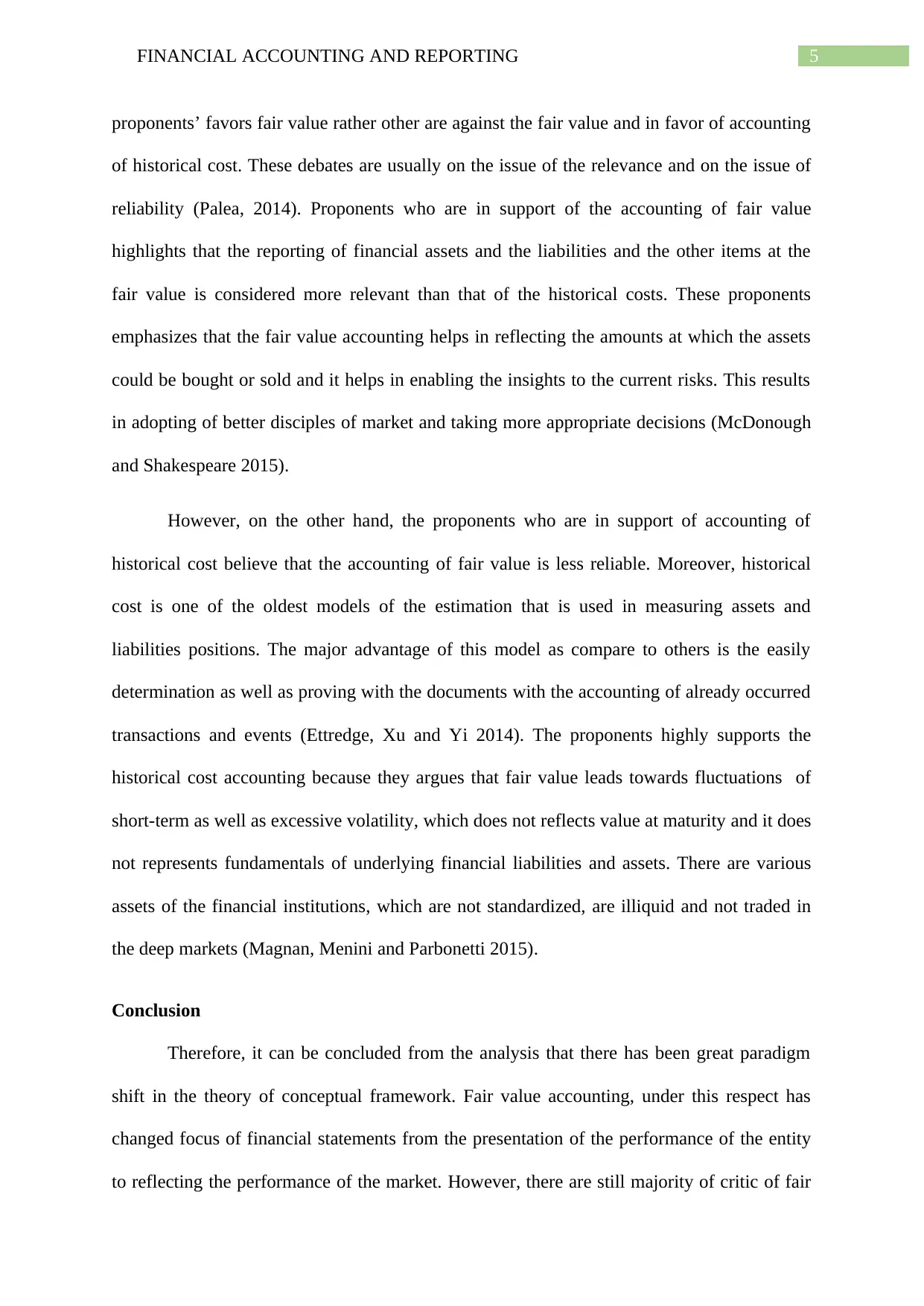
5FINANCIAL ACCOUNTING AND REPORTING
proponents’ favors fair value rather other are against the fair value and in favor of accounting
of historical cost. These debates are usually on the issue of the relevance and on the issue of
reliability (Palea, 2014). Proponents who are in support of the accounting of fair value
highlights that the reporting of financial assets and the liabilities and the other items at the
fair value is considered more relevant than that of the historical costs. These proponents
emphasizes that the fair value accounting helps in reflecting the amounts at which the assets
could be bought or sold and it helps in enabling the insights to the current risks. This results
in adopting of better disciples of market and taking more appropriate decisions (McDonough
and Shakespeare 2015).
However, on the other hand, the proponents who are in support of accounting of
historical cost believe that the accounting of fair value is less reliable. Moreover, historical
cost is one of the oldest models of the estimation that is used in measuring assets and
liabilities positions. The major advantage of this model as compare to others is the easily
determination as well as proving with the documents with the accounting of already occurred
transactions and events (Ettredge, Xu and Yi 2014). The proponents highly supports the
historical cost accounting because they argues that fair value leads towards fluctuations of
short-term as well as excessive volatility, which does not reflects value at maturity and it does
not represents fundamentals of underlying financial liabilities and assets. There are various
assets of the financial institutions, which are not standardized, are illiquid and not traded in
the deep markets (Magnan, Menini and Parbonetti 2015).
Conclusion
Therefore, it can be concluded from the analysis that there has been great paradigm
shift in the theory of conceptual framework. Fair value accounting, under this respect has
changed focus of financial statements from the presentation of the performance of the entity
to reflecting the performance of the market. However, there are still majority of critic of fair
proponents’ favors fair value rather other are against the fair value and in favor of accounting
of historical cost. These debates are usually on the issue of the relevance and on the issue of
reliability (Palea, 2014). Proponents who are in support of the accounting of fair value
highlights that the reporting of financial assets and the liabilities and the other items at the
fair value is considered more relevant than that of the historical costs. These proponents
emphasizes that the fair value accounting helps in reflecting the amounts at which the assets
could be bought or sold and it helps in enabling the insights to the current risks. This results
in adopting of better disciples of market and taking more appropriate decisions (McDonough
and Shakespeare 2015).
However, on the other hand, the proponents who are in support of accounting of
historical cost believe that the accounting of fair value is less reliable. Moreover, historical
cost is one of the oldest models of the estimation that is used in measuring assets and
liabilities positions. The major advantage of this model as compare to others is the easily
determination as well as proving with the documents with the accounting of already occurred
transactions and events (Ettredge, Xu and Yi 2014). The proponents highly supports the
historical cost accounting because they argues that fair value leads towards fluctuations of
short-term as well as excessive volatility, which does not reflects value at maturity and it does
not represents fundamentals of underlying financial liabilities and assets. There are various
assets of the financial institutions, which are not standardized, are illiquid and not traded in
the deep markets (Magnan, Menini and Parbonetti 2015).
Conclusion
Therefore, it can be concluded from the analysis that there has been great paradigm
shift in the theory of conceptual framework. Fair value accounting, under this respect has
changed focus of financial statements from the presentation of the performance of the entity
to reflecting the performance of the market. However, there are still majority of critic of fair
⊘ This is a preview!⊘
Do you want full access?
Subscribe today to unlock all pages.

Trusted by 1+ million students worldwide
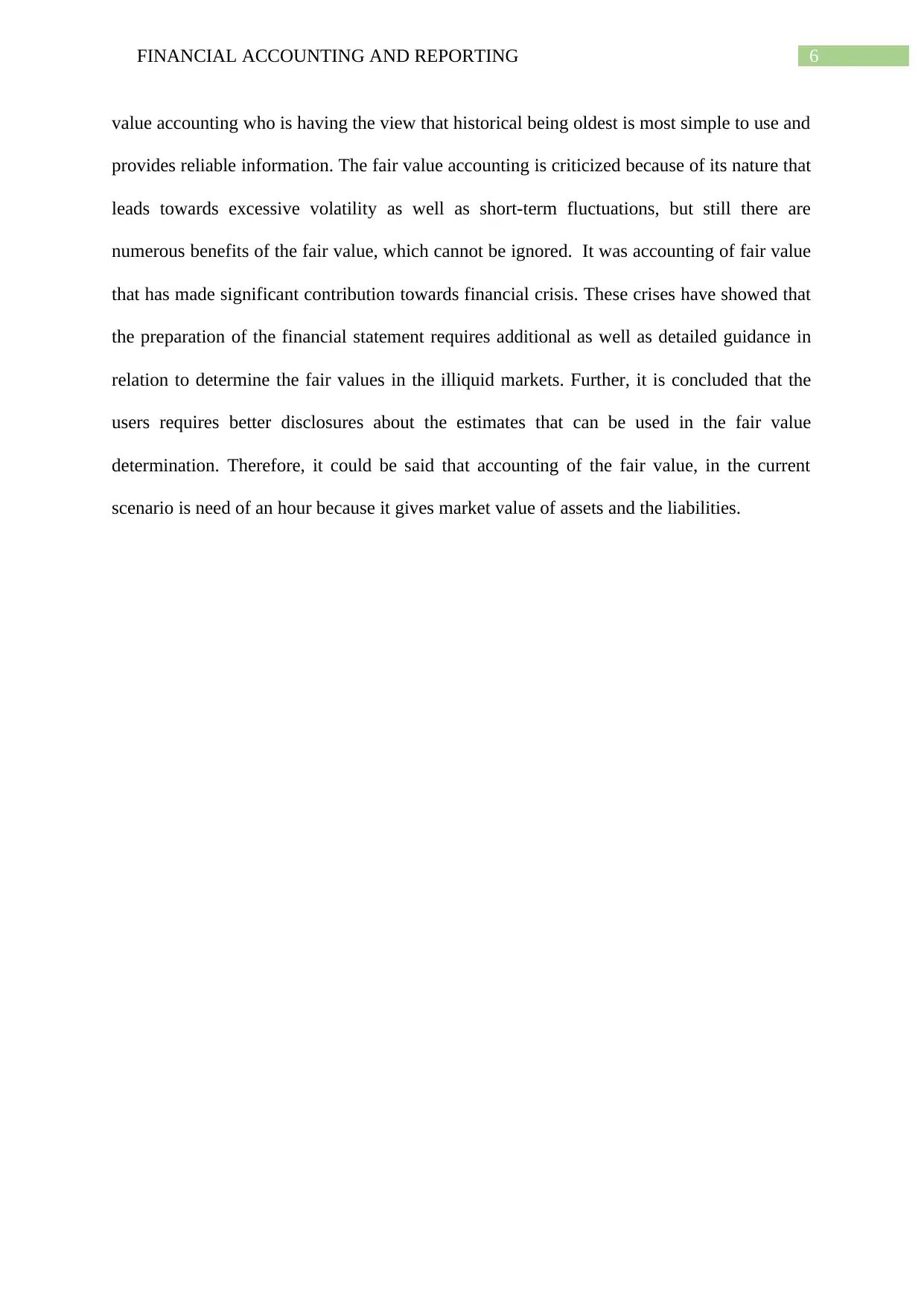
6FINANCIAL ACCOUNTING AND REPORTING
value accounting who is having the view that historical being oldest is most simple to use and
provides reliable information. The fair value accounting is criticized because of its nature that
leads towards excessive volatility as well as short-term fluctuations, but still there are
numerous benefits of the fair value, which cannot be ignored. It was accounting of fair value
that has made significant contribution towards financial crisis. These crises have showed that
the preparation of the financial statement requires additional as well as detailed guidance in
relation to determine the fair values in the illiquid markets. Further, it is concluded that the
users requires better disclosures about the estimates that can be used in the fair value
determination. Therefore, it could be said that accounting of the fair value, in the current
scenario is need of an hour because it gives market value of assets and the liabilities.
value accounting who is having the view that historical being oldest is most simple to use and
provides reliable information. The fair value accounting is criticized because of its nature that
leads towards excessive volatility as well as short-term fluctuations, but still there are
numerous benefits of the fair value, which cannot be ignored. It was accounting of fair value
that has made significant contribution towards financial crisis. These crises have showed that
the preparation of the financial statement requires additional as well as detailed guidance in
relation to determine the fair values in the illiquid markets. Further, it is concluded that the
users requires better disclosures about the estimates that can be used in the fair value
determination. Therefore, it could be said that accounting of the fair value, in the current
scenario is need of an hour because it gives market value of assets and the liabilities.
Paraphrase This Document
Need a fresh take? Get an instant paraphrase of this document with our AI Paraphraser
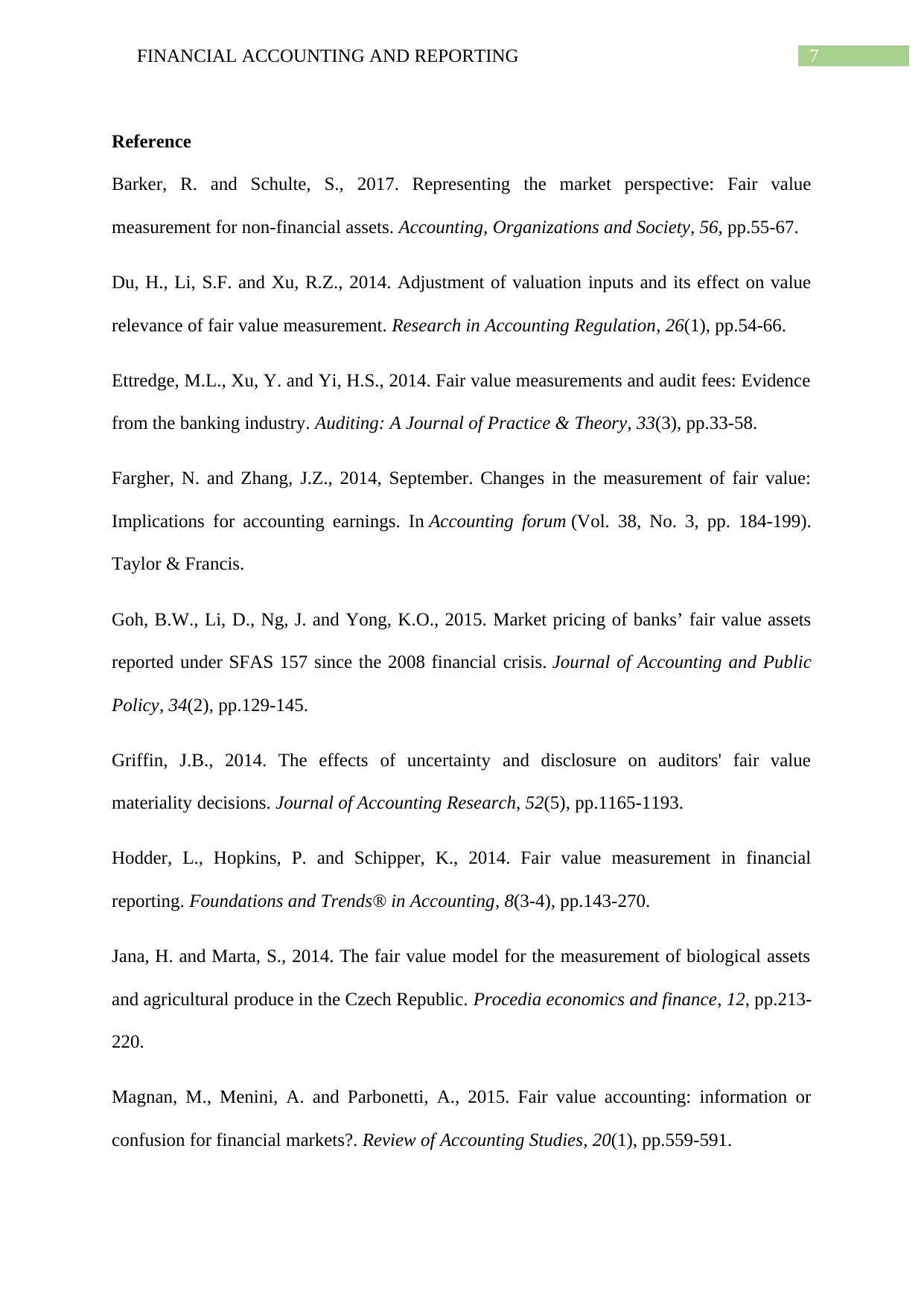
7FINANCIAL ACCOUNTING AND REPORTING
Reference
Barker, R. and Schulte, S., 2017. Representing the market perspective: Fair value
measurement for non-financial assets. Accounting, Organizations and Society, 56, pp.55-67.
Du, H., Li, S.F. and Xu, R.Z., 2014. Adjustment of valuation inputs and its effect on value
relevance of fair value measurement. Research in Accounting Regulation, 26(1), pp.54-66.
Ettredge, M.L., Xu, Y. and Yi, H.S., 2014. Fair value measurements and audit fees: Evidence
from the banking industry. Auditing: A Journal of Practice & Theory, 33(3), pp.33-58.
Fargher, N. and Zhang, J.Z., 2014, September. Changes in the measurement of fair value:
Implications for accounting earnings. In Accounting forum (Vol. 38, No. 3, pp. 184-199).
Taylor & Francis.
Goh, B.W., Li, D., Ng, J. and Yong, K.O., 2015. Market pricing of banks’ fair value assets
reported under SFAS 157 since the 2008 financial crisis. Journal of Accounting and Public
Policy, 34(2), pp.129-145.
Griffin, J.B., 2014. The effects of uncertainty and disclosure on auditors' fair value
materiality decisions. Journal of Accounting Research, 52(5), pp.1165-1193.
Hodder, L., Hopkins, P. and Schipper, K., 2014. Fair value measurement in financial
reporting. Foundations and Trends® in Accounting, 8(3-4), pp.143-270.
Jana, H. and Marta, S., 2014. The fair value model for the measurement of biological assets
and agricultural produce in the Czech Republic. Procedia economics and finance, 12, pp.213-
220.
Magnan, M., Menini, A. and Parbonetti, A., 2015. Fair value accounting: information or
confusion for financial markets?. Review of Accounting Studies, 20(1), pp.559-591.
Reference
Barker, R. and Schulte, S., 2017. Representing the market perspective: Fair value
measurement for non-financial assets. Accounting, Organizations and Society, 56, pp.55-67.
Du, H., Li, S.F. and Xu, R.Z., 2014. Adjustment of valuation inputs and its effect on value
relevance of fair value measurement. Research in Accounting Regulation, 26(1), pp.54-66.
Ettredge, M.L., Xu, Y. and Yi, H.S., 2014. Fair value measurements and audit fees: Evidence
from the banking industry. Auditing: A Journal of Practice & Theory, 33(3), pp.33-58.
Fargher, N. and Zhang, J.Z., 2014, September. Changes in the measurement of fair value:
Implications for accounting earnings. In Accounting forum (Vol. 38, No. 3, pp. 184-199).
Taylor & Francis.
Goh, B.W., Li, D., Ng, J. and Yong, K.O., 2015. Market pricing of banks’ fair value assets
reported under SFAS 157 since the 2008 financial crisis. Journal of Accounting and Public
Policy, 34(2), pp.129-145.
Griffin, J.B., 2014. The effects of uncertainty and disclosure on auditors' fair value
materiality decisions. Journal of Accounting Research, 52(5), pp.1165-1193.
Hodder, L., Hopkins, P. and Schipper, K., 2014. Fair value measurement in financial
reporting. Foundations and Trends® in Accounting, 8(3-4), pp.143-270.
Jana, H. and Marta, S., 2014. The fair value model for the measurement of biological assets
and agricultural produce in the Czech Republic. Procedia economics and finance, 12, pp.213-
220.
Magnan, M., Menini, A. and Parbonetti, A., 2015. Fair value accounting: information or
confusion for financial markets?. Review of Accounting Studies, 20(1), pp.559-591.
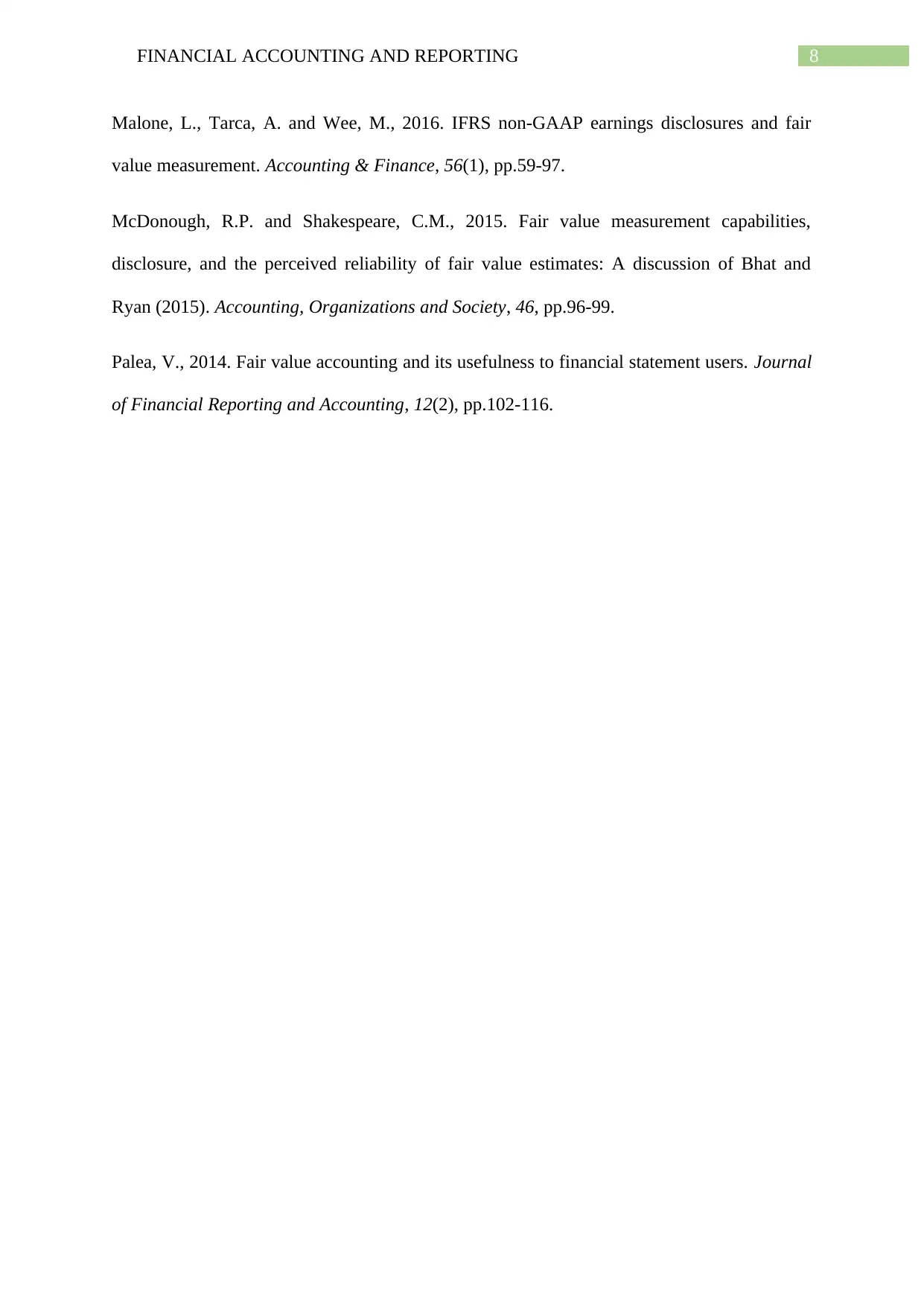
8FINANCIAL ACCOUNTING AND REPORTING
Malone, L., Tarca, A. and Wee, M., 2016. IFRS non‐GAAP earnings disclosures and fair
value measurement. Accounting & Finance, 56(1), pp.59-97.
McDonough, R.P. and Shakespeare, C.M., 2015. Fair value measurement capabilities,
disclosure, and the perceived reliability of fair value estimates: A discussion of Bhat and
Ryan (2015). Accounting, Organizations and Society, 46, pp.96-99.
Palea, V., 2014. Fair value accounting and its usefulness to financial statement users. Journal
of Financial Reporting and Accounting, 12(2), pp.102-116.
Malone, L., Tarca, A. and Wee, M., 2016. IFRS non‐GAAP earnings disclosures and fair
value measurement. Accounting & Finance, 56(1), pp.59-97.
McDonough, R.P. and Shakespeare, C.M., 2015. Fair value measurement capabilities,
disclosure, and the perceived reliability of fair value estimates: A discussion of Bhat and
Ryan (2015). Accounting, Organizations and Society, 46, pp.96-99.
Palea, V., 2014. Fair value accounting and its usefulness to financial statement users. Journal
of Financial Reporting and Accounting, 12(2), pp.102-116.
⊘ This is a preview!⊘
Do you want full access?
Subscribe today to unlock all pages.

Trusted by 1+ million students worldwide
1 out of 9
Related Documents
Your All-in-One AI-Powered Toolkit for Academic Success.
+13062052269
info@desklib.com
Available 24*7 on WhatsApp / Email
![[object Object]](/_next/static/media/star-bottom.7253800d.svg)
Unlock your academic potential
Copyright © 2020–2025 A2Z Services. All Rights Reserved. Developed and managed by ZUCOL.





